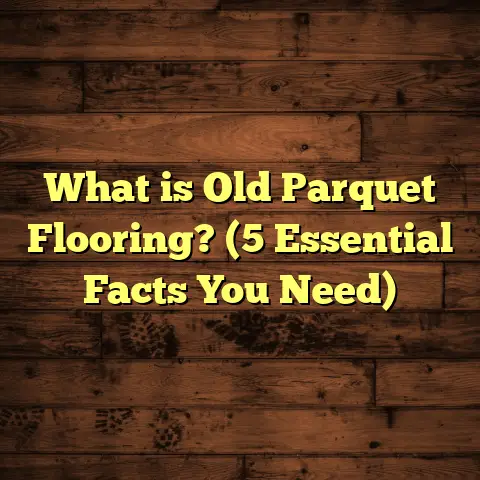What is Floor Painting? (7 Benefits for Stunning Spaces)
Springtime always brings a burst of energy to my home improvement projects. There’s something about the longer days and warmer air that makes me want to shake off the winter gloom and refresh my living spaces. One of my favorite ways to do this lately has been through floor painting. It’s like giving your floors a brand-new outfit without the hassle or cost of replacing them.
If you’re curious about what floor painting involves, how it works, or whether it could be right for your home, pull up a chair. I’ll walk you through everything I’ve learned over years of working hands-on with floors of all kinds. We’ll explore what floor painting is, how to do it right, and why it might just be the best move for your next project.
What is Floor Painting?
Floor painting is the process of applying specially formulated paint to a floor surface to improve its appearance, durability, or both. It differs from regular wall or furniture painting because it requires products that can handle foot traffic, furniture movement, spills, and sometimes outdoor exposure.
The Basics
When I first started working with floor painting, I thought it was simply about slapping paint onto a surface. Quickly, I learned that’s not the case. The paints used are designed to be tough—often epoxy or polyurethane-based—and they create a hard-wearing layer that protects the floor underneath.
Floors can be concrete, wood, vinyl, or even metal in some cases. Each material needs a different approach and paint type. For example:
- Concrete floors: Usually require an epoxy or acrylic paint because concrete is porous and can absorb moisture.
- Wood floors: Need a paint that can flex slightly as wood expands and contracts.
- Vinyl floors: Can be painted but need proper cleaning and sometimes a primer to help the paint stick.
Why Paint Floors Instead of Replacing Them?
When I meet homeowners or business owners considering floor painting, they often ask me why not just replace the floors instead of painting them? Here’s what I usually tell them:
- Painting is cheaper by a large margin.
- It’s faster and less disruptive since you don’t have to tear anything out.
- Painting can cover up stains, cracks, and imperfections that would otherwise require expensive repairs.
- It’s eco-friendly because it reuses existing materials instead of sending old floors to the landfill.
My Experience with Floor Painting Projects
Over the years, I’ve worked on dozens of floor painting projects—everything from small rental apartments to large commercial garages. I remember one winter when a client asked me to brighten up their basement with a dark, cracked concrete floor. After some cleaning and patching, we applied a light gray epoxy-based paint with a speckled finish. The difference was incredible! The room instantly felt cleaner and more inviting.
Another memorable project was repainting hardwood floors in an old farmhouse. The floors had seen decades of wear, and sanding wasn’t an option because the wood was too thin. After careful cleaning and priming, we chose a durable latex floor paint in a warm beige tone. The finish held up well under daily use and gave the house a fresh new vibe without losing its rustic charm.
These experiences showed me that floor painting isn’t just about aesthetics—it’s about making floors last longer and function better.
How to Use Floor Paint: Practical Information
If you’re ready to give floor painting a try yourself or want to understand what goes into hiring someone for the job, here’s a practical guide from my toolbox.
Choosing the Right Paint
Not all paints are created equal for floors. Here are some common types:
- Epoxy Paints: Known for durability and chemical resistance. Great for garages, basements, and industrial spaces.
- Acrylic Floor Paints: Easier to apply and dry fast but less durable than epoxy. Good for low-traffic areas.
- Polyurethane Floor Paints: Offer flexibility and are resistant to abrasion; ideal for wood floors.
- Chalk Paints: Used sometimes for decorative effects on wood; usually sealed with a protective topcoat.
When picking paint, consider where you’ll use it (indoor/outdoor), how much foot traffic there is, and if you want matte or glossy finishes.
Preparing Your Floor
Preparation can make or break your project. I cannot stress this enough from my personal experience—poor prep leads to peeling paint later on.
- Clean thoroughly: Remove dirt, grease, wax, or any residue.
- Repair cracks or holes: Use appropriate fillers.
- Sand smooth: This helps paint stick better on wood or glossy surfaces.
- Etch concrete if needed: Acid etching opens up the surface for better adhesion.
- Prime: Some surfaces benefit from a primer layer that seals and improves bonding.
Application Tips
I usually recommend applying paint in thin layers using rollers designed for smooth surfaces. Brush edges neatly for crisp lines. Two coats are typically necessary; three if you want extra durability.
Drying times vary but expect at least 24 hours between coats and 72 hours before heavy use.
Sealing for Protection
A topcoat seals the paint and adds scratch resistance. Polyurethane clear coats are popular choices.
Maintenance of Painted Floors
One thing clients often ask me is how long painted floors last and how to keep them looking good. Here’s what I tell them:
- Sweep or vacuum regularly to avoid dirt scratches.
- Mop with mild soap solutions; avoid harsh cleaners that can degrade paint.
- Use furniture pads to protect against dents.
- Address chips promptly by spot-painting.
- Reapply sealer every few years depending on wear.
Proper maintenance can make painted floors last 5–10 years or more.
7 Benefits of Floor Painting for Stunning Spaces
Now let’s get into why I’m such a fan of floor painting. These benefits go way beyond just changing color.
1. Cost Savings That Let You Get Creative
Replacing floors can cost thousands depending on materials and labor. Painting supplies usually run under $2 per square foot plus labor if you hire out.
For example, repainting a 300-square-foot basement floor may cost around $500 in materials versus $3,000+ for new tile installation.
This affordability gives you freedom to experiment with colors and patterns without worry.
2. Customize Your Space Exactly How You Want It
One of the most exciting parts for me is playing with design possibilities. You’re not limited to wood tones or tile shapes anymore—you can create geometric patterns, stencils, faux textures (like marble or tile), or bold color blocks.
I’ve used painter’s tape extensively to create stripes or chevrons that completely modernize spaces.
3. Protect Your Floors From Wear and Tear
Paints like epoxy form tough barriers that resist stains from oil spills in garages or water damage in basements. In commercial settings where floors take abuse from forklifts or heavy equipment, painted floors reduce long-term damage costs.
4. Environmentally Friendly Option
By painting instead of replacing, we reduce waste going into landfills—something many clients appreciate today.
Also, many manufacturers now offer low-VOC (volatile organic compound) paints that minimize harmful emissions during application.
5. Fast Turnaround Saves Time
Compared with ripping out old flooring and installing new material (which can take several days or weeks), painting floors can be completed in a few days including drying time.
This speed is crucial when you need your space functional quickly—like before hosting events or reopening businesses after renovations.
6. Works on Almost Any Surface
Paint formulations exist for almost every flooring type from concrete to hardwood to vinyl tiles. This versatility means you can refresh many different rooms without worrying about compatibility issues.
7. Brightens Dark Spaces Visually
Light-colored painted floors reflect more light than traditional flooring options like dark wood or carpet. This effect visually enlarges rooms and makes them feel more welcoming—perfect for basements or rooms with limited windows.
Data-Backed Insights and Research on Floor Painting
I like combining hands-on experience with solid data to support my recommendations.
Industry Cost Comparison
According to recent research by HomeAdvisor, the average cost per square foot for:
- New hardwood flooring installation: $8 – $14
- New tile flooring installation: $7 – $15
- Floor painting (materials only): $1 – $3
- Professional floor painting labor: $2 – $5 per square foot
This means even factoring in labor, painting often costs less than 30% of replacement expenses.
Durability Studies
A study published by the Journal of Coatings Technology tested epoxy-coated concrete floors in industrial environments over five years. Results showed minimal wear and excellent resistance to chemicals and abrasion compared to uncoated concrete.
Customer Satisfaction
In surveys conducted by flooring companies offering painting services:
- Over 80% of customers reported their painted floors looked “like new” after one year.
- 70% said painted floors were easier to clean than their previous flooring.
- More than half of respondents said they would choose painted floors again due to cost savings.
These stats align with my direct conversations with clients who often mention how surprised they are by the quality and longevity of painted floors.
Case Study: Transforming a Garage Floor with Epoxy Paint
Last year, I worked with a homeowner who wanted her garage floor fixed after years of oil stains and cracks made it look like an eyesore.
We started by pressure washing and repairing cracks with epoxy filler. Then we applied an industrial-grade epoxy paint designed for garage use in two coats plus a clear polyurethane sealer on top.
The result? A glossy, durable surface that resisted stains immediately and brightened the entire space. She told me she no longer dreaded parking or working in her garage—and said she’d recommend floor painting to anyone struggling with similar issues.
Case Study: Artistic Floor Mural in an Art Studio
A local artist wanted her studio floor painted with an original design that could stand up to messy paint splatters but still inspire creativity.
After testing several paints for adhesion and durability on concrete, we settled on a flexible polyurethane basecoat followed by hand-painted motifs sealed under multiple clear coats.
The studio became not just a workspace but an artwork itself—the floor reflecting her personality while providing protection against damage from her creative process.
Tips From My Own Experience
Here are some lessons I’ve learned the hard way:
- Don’t underestimate prep time; give yourself at least double what you think.
- Invest in quality paint—even if it costs more upfront, it lasts longer.
- When applying paint outdoors, watch for weather changes like humidity or sudden rain.
- Use painter’s tape liberally if you want sharp edges or patterns.
- Always test paint on small hidden areas first so you can see how it looks when dry.
Should You DIY or Hire a Pro?
If you enjoy hands-on projects and have patience for preparation work, floor painting is definitely something you can try yourself. Many hardware stores carry kits with all supplies included nowadays.
However, if you’re short on time or want guaranteed results (especially on tricky surfaces like uneven concrete), hiring a professional saves headaches. Pros bring experience in surface prep techniques like acid etching concrete or using industrial primers that amateurs might overlook.
Wrapping Up Thoughts
Painting your floors can transform bland spaces into something fresh, functional, and unique without draining your wallet. Whether refreshing an old basement, brightening a garage, or creating custom designs on wood floors, floor painting offers benefits that go beyond just looks—it protects your investment and extends your floor’s life.
If you’re feeling inspired this spring like I do every year, maybe consider giving your floors some color love too. And if you do take the plunge—whether DIY or pro—remember that preparation is key and patience pays off in beautiful results that last years.
Got questions? Want advice on your specific floor type? Just ask—I’ve got plenty more stories and tips ready to share!





